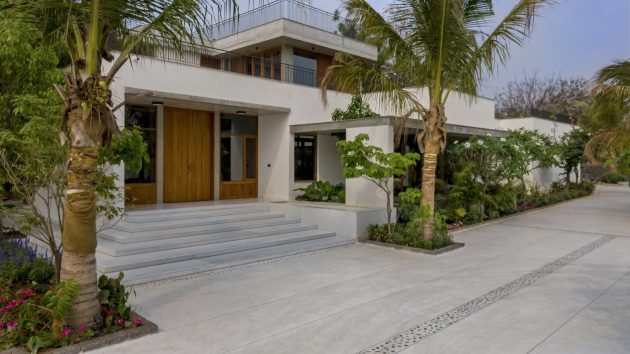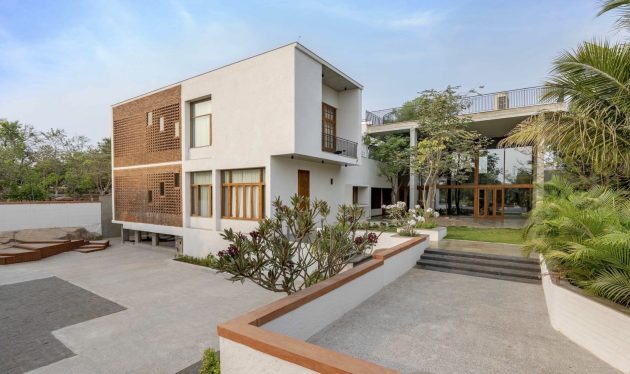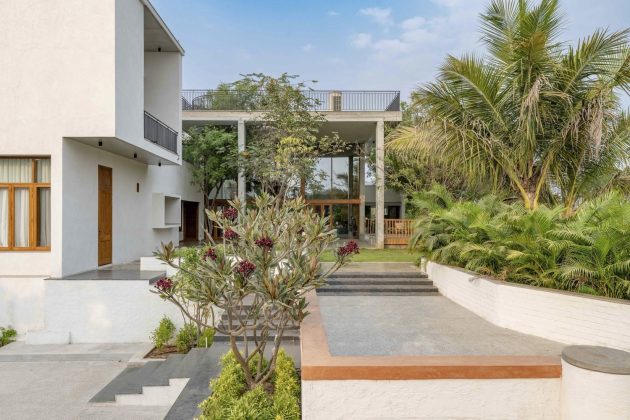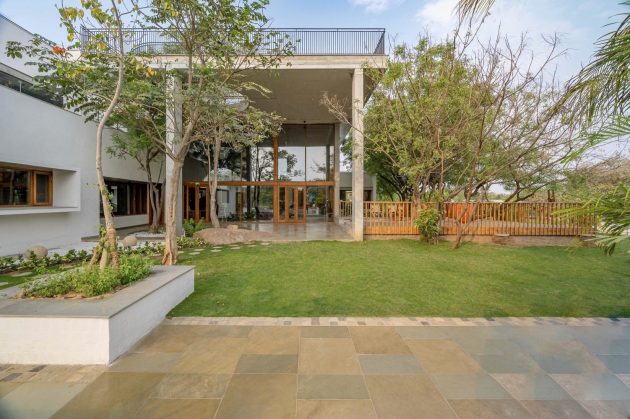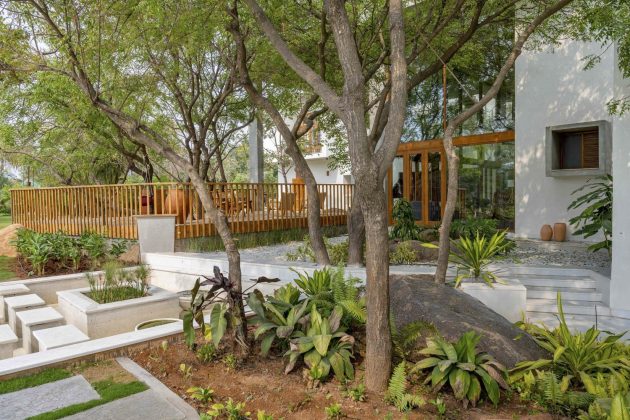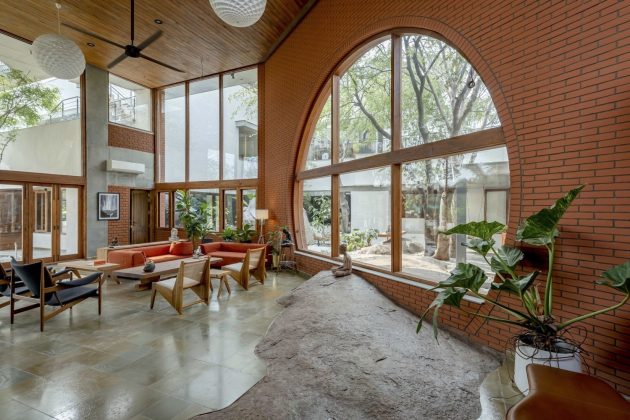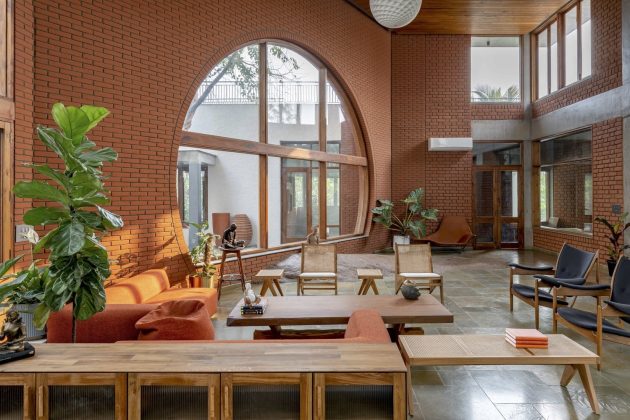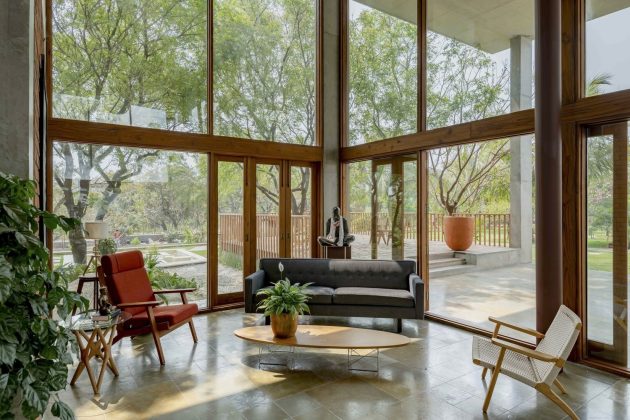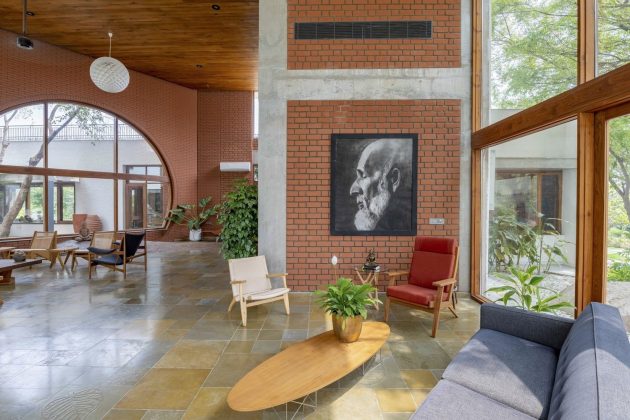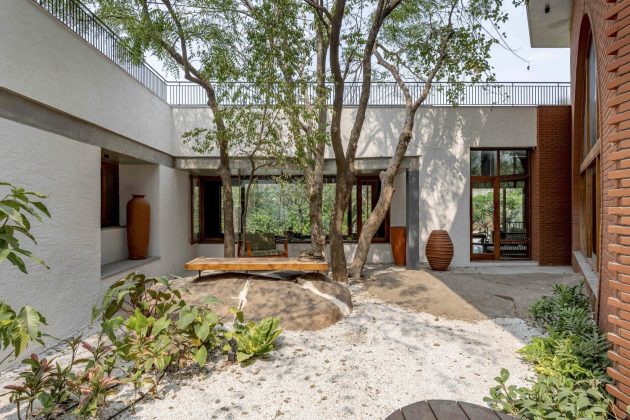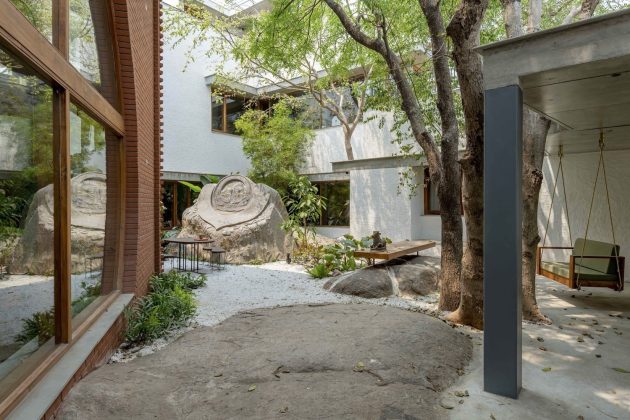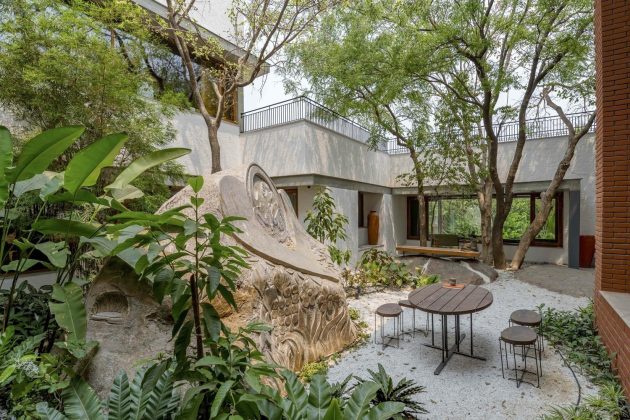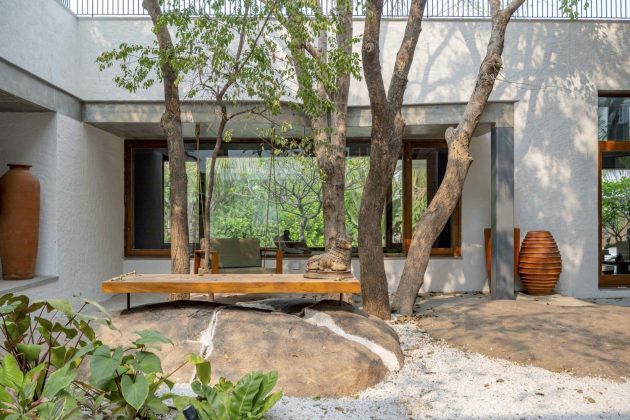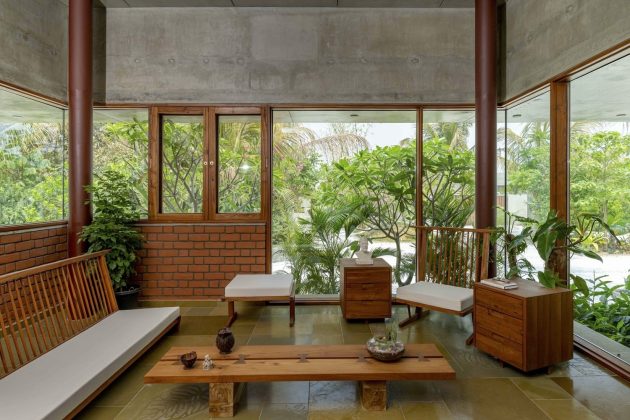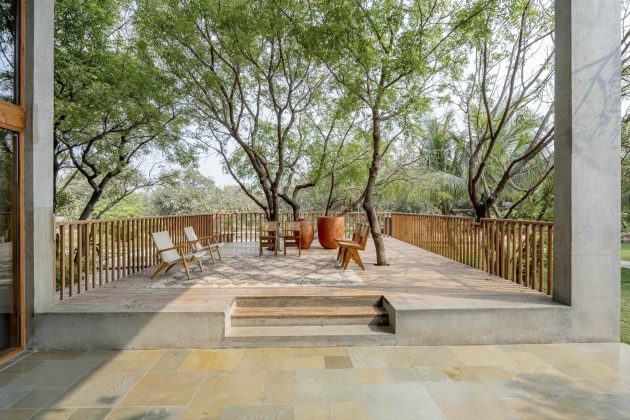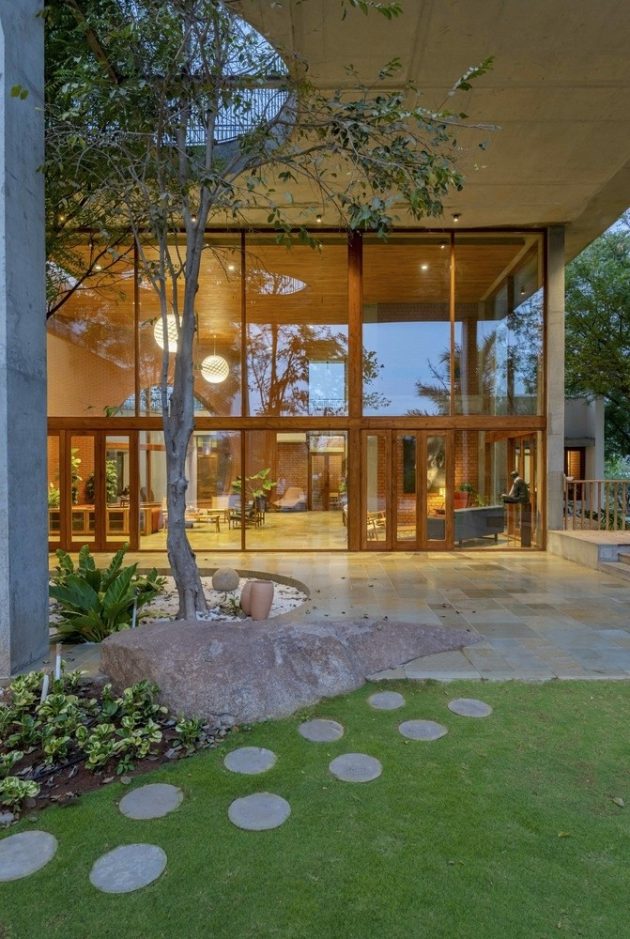Project: Daaji’s Home
Architects: The Grid Architects
Location: Ahmedabad, India
Area: 42,532 sf
Year: 2022
Photographs by: Vinay Panjwani
Daaji’s Home by The Grid Architects
Daaji’s Home, designed by The Grid Architects in Ahmedabad, India, is a remarkable embodiment of biophilic architecture and biomorphism. This residence harmoniously blends with its natural surroundings, allowing rocks and trees to shape its form. The use of earthy, local materials such as red bricks, lime plaster, and Kota stone further reinforces its connection to the environment. Sustainability is prioritized through rainwater collection ponds, integration of local species of plants, and a deliberate design that respects the existing trees. Daaji’s Home invites residents to experience a profound connection with nature, creating a serene and harmonious living environment.
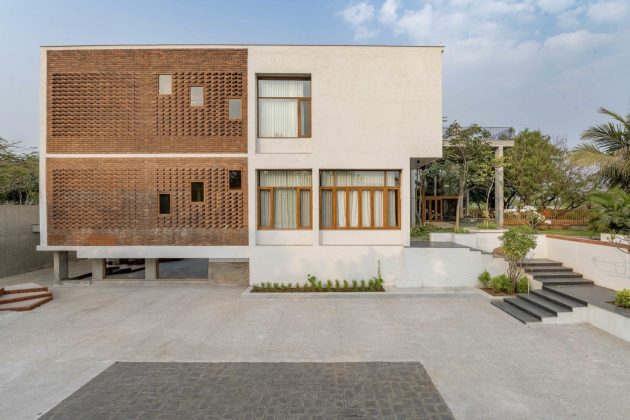
A home following biophilic ideology and influenced by Biomorphism. Note: ¾ of the total plot area has been left free ¼ of the total plot area has a built form.
The starting point
What is home? Is it an enclosure of bricks and mortar? Or a feeling, an emotion? Will it be enough just to be the one and not the other? Or is it a confluence of the corporal and the abstract, a meeting ground of the tangible and the intangible, an intersection of the mind and the body?
These are some of the introspections we did when designing a home for Daaji, the WORLD spiritual leader of the Sahaj Marg (Heartfulness) path of meditation. That our deliberations became tinged with the metaphysical was not surprising. We also paid heed to Daaji’s notion of a home — a place where ‘you’ and ‘I’ are supplanted with ‘us’, where we can cultivate a comfortable and warm atmosphere in addition to its physical location. As a result, we strove towards simplicity of articulation and richness of spirit and endeavored for a space that embodied human emotions and sentiments rather than being an enclosure erected with building materials. The paradigm of togetherness and being oneself was thus set by Daaji’s house.
The site
The house is situated in the Heartfulness Centre at Kanha Shantivanam in Hyderabad, in a gated community. The land, initially, was full of rocks with a few existing trees. These rocks, it is said, are primeval entities, one of the very first in the world. Sensing their intrinsic preciousness and uniqueness, Daaji wished to keep them in situ. This, thus, became a challenge while planning the organization and executing the footprint of the house.
The form
The site was paramount when it came to formalizing the built-envelope. The movement of the home was controlled by the positioning of the stones and trees. We took inspiration from water to create a fluidic plan that wrapped around trees and flowed around rocks, imbibing the very essence of nature into its form. The house is low and spreads over the site in order to blend with the surroundings. A development that minimized the vertical allowed the building to be physically connected to the land in a stronger manner, letting natural aspects such as trees be visually dominant.
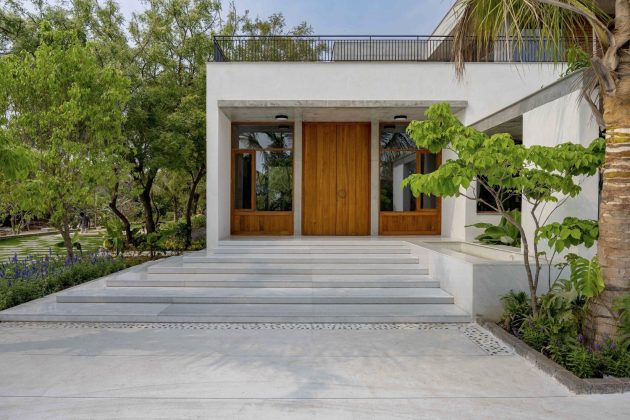
The Materiality
As with all our projects, nature has driven the materiality of the home. Simple, humble materials imbued with the beauty and the goodness of Earth drive the narrative towards a warm contextual-ness that resonates with elemental energies. Red bricks complement the cool Kota stone flooring. Simple lime plaster clads the various edifices. And yet, the material does not end here. The trees, the rocks, the sunlight, and the air all contribute to creating experiential juxtapositions that are effortless and enduring.
The internal program
The north entrance of the house guides you to a vestibule and, subsequently, two internal passages. As the client receives many visitors and dignitaries, it became very important to ensure some privacy for him. Thus, one passage leads to the main living room, whereas the other takes you to a study room and Daaji’s bedroom. The ground floor consists of the living and the dining area as the main spaces for public access, while the rest of the house — including the upper storey comprising full of bedrooms — is designated as a private zone. The living room of the house was designed to be comparatively more spacious than other homes due to a large number of people walking in throughout the day. The well-lit room opens on the south to an external platform, forming an extension to the living room. The dining and the kitchen adjoin the living room. Just like the living room, the dining room, too, overlooks the central courtyard on both sides which directly let in the north light. The kitchen is segregated into a wet and dry area and makes considerable room for cooking utensils. This ensures better coordination during large gatherings.
Celebrating nature
The central idea while scripting this design was nature — architecturally as well as in the internal articulation. Just as the gentle, demure built-form lets nature take precedence, internally, too, courtyards, hallways, and other spaces are integrated with the surroundings. The arrangement of each room was orientated towards nature. The skewed wall in the living room, for instance, allows a massive rock to come inside the room, so that the monolith lies partly enclosed and partly outside in the adjacent courtyard. The angular deployment also ensures sufficient light from the south, southeast, and northwest directions. Similarly, a wall of the outdoor verandah was whittled away to make way for the tree to grow through the cut-out.
Special features
The home is part of a gated community living. The surrounding landscape has been developed by adding ponds that collect the rainwater that is used to irrigate the area around the home as well as the communal landscape. The development also houses the world’s biggest meditation hall. The home features an organic material palette comprising red bricks (for masonry), lime plaster, and Kota stone. The alignment of the built form and the ecosystem with its existing rocks became a part of the construction process. The jugalbandi of the trees, rocks, and the built form enriched the space to be grown as a part of nature rather than out of it.
The biophilic idea of living with vegetation played an important role in the material palette.
There was no specific execution drawing for the project since it was derived with respect to the existing ecology. The elements were not restricted to just local species of plants but also extended to rainwater harvesting. The usage of charcoal, a natural fertilizer, played a huge role in developing the greenery around. The height of the building not exceeding the existing trees was deliberately done to prevent the architecture from asserting dominance — symbolizing nature to be above all.
Conclusion
Daaji’s home is designed with the intention of being shaped by nature, built by nature and growing as part of nature. It is inspired by and respects the system of an Indian household addressing togetherness, sacrifice, and, above all, love. The biophilic architecture of the house interweaves the spaces with these sentimental values. This makes this house a ‘home’ — making it clear that it is not just the strength of brick but also the strength of love that binds the roots of the home.
Special features/sustainability
We used earthy, local materials, shaped and worked by local hands, to build this modest, private retreat.
The material palette is an organic material palette comprising red bricks (for masonry locally made onsite) lime plaster and Kota stone.
Natural stone is an energy-efficient and climate-responsive material choice creating dialogues with the architecture and interior.
The skewed wall in the living room, for instance, allows a massive rock to come inside the room, so that the monolith lies partly enclosed and partly outside in the adjacent courtyard. The angular deployment also ensures sufficient light from the south, southeast, and northwest directions. Similarly, a wall of the outdoor verandah was whittled away to make way for the tree to grow through the cut-out.
The surrounding landscape has been developed by adding ponds that collect the rainwater that is used to irrigate the area around the home as well as the communal landscape.
The elements were not restricted to just local species of plants but also extended to rainwater harvesting. The usage of charcoal, a natural fertilizer, played a huge role in developing the greenery around.
The height of the building not exceeding the existing trees was deliberately done to prevent the architecture from asserting dominance — symbolizing nature to be above all.
The surroundings were left largely undisturbed while building this ecologically sensitive accommodation encouraging biodiversity.
The microecology of the waterbodies, natural local special of plants build their own ecosystem.
Throughout the home, openable fully glazed windows usher in breeze and fresh air. Warm sunlight and green trees add to human health.
The interior spaces are flanked on all sides by green pockets alternately and are visually and physically linked to the central courtyard, underscoring again the philosophy of being one with nature.
The site is surrounded by large local mature trees that act as natural sun-breakers, having all the pathways and the periphery of the home.

